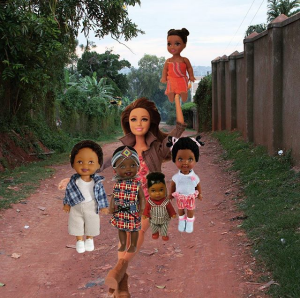You may have read my How to be a Clicktivist post, you ought to know that being a White Saviour is a level up in the Development Game.

Unlike Clicktivism, White Saviourism is not a new phenomenon (colonialism, anyone?). Sure, these days White Saviours don’t commit genocides, enslave people, and steal their natural resources (kinda…), but the eugenics at the heart of it all is still there: “I know what’s best for you: be more like me!”
If you want a quick answer on what White Saviour is, have a look at the Instagram account @barbiesaviour. Barbie Saviour captures the parallel between Clicktivism and White Saviourism with humour and irony. With 168,000 followers, and the use of hashtags like #wheredemorphansat, Barbie Saviour makes fun of every white wo/man who has gone to “help” in “Africa”. By photoshopping Barbie into stereotypical images of poverty with hilarious captions, the author highlights all that’s wrong with White Saviourism.

The choice of a Barbie doll is not incidental. The privileged, tall, slim, white woman saving starving children is unfortunately an image that still sells. A 2017 article by Hopkins published in the International Communication Gazette titled UN Celebrity ‘it’ girls: as public relations-ised humanitarianism gives a sobering insight into the phenomenon – enough to make anyone with half a conscience feel sick. An analysis of how ‘celebrity activism’ is represented in Australian women’s magazines, the phenomenon can be summed up in one sentence: “Perhaps, it is not that the celebrity ambassador empowers marginalized ‘others’, but rather that the marginalized others are used to empower the celebrity, and to further enhance her fame, fortune, and socio-political legitimacy” (p.4).
With celebrities like Angeline Jolie, Emma Watson, and Nicole Kidman appointed UN Goodwill Ambassadors, the message sent to the public is that the reason these women can make such a difference in the world is that they’re white, beautiful, and accomplished – and not because of a keen interest or knowledge of a situation (Hopkins).
White men aren’t excluded of course, with David Beckham, Tom Hardy, and Ed Sheeran doing their bit for the White Saviour team, the latter causing such a backlash for his Comic Relief video that it was pulled off the web. Despite Comic Relief promising to stop perpetuating stereotypes, they put their foot into it again when they sent Stacey Dooley to Uganda, where she proceeded take a selfie with a child she didn’t know, without parental permission, and post it on instagram with the caption “OB.SESSSSSSSSSSED 💔 ”

The Ugandan organisation No White Saviours extended a hand to Stacey Dooley, offering feedback and an opportunity to rectify, which she ignored. (The selfie above, and another similar image are still on her instagram page, despite hundreds of comments begging her to remove them.)
Hopkins echoes Teju Cole’s essay, in which he coined the term White Saviour Industrial Complex: “Africa has provided a space onto which white egos can conveniently be projected.” (2012), which in turn echoes bell hooks’ essay “Eating the Other: Desire and Resistance” in which she explains the power and privilege grab that comes from exploiting the less fortunate.
So why do we white people push back, ignore, deny the voices that are calling out the behaviour as condescending and shortsighted at best, or racist at its worst? Robin Di Angelo defines White Fragility as “the inability of white people to tolerate racial stress” due to the systems that keep our lives separate and pleasant, we are unable to handle difficult conversations about racism and therefore avoid them at all costs.
The good thing about The Internet is that as well as being a vehicle for White Saviours to harvest glory, it is also a vehicle to call out the B.S. If, like me, after scrolling through Dooley’s instagram feed you need to restore your faith in humanity, here are some good places to start:
- Follow No White Saviours
- Have a look at RadiAid flipping the formula
- Listen to Black Lives Matter
- Absorb the notion of White Fragility
- Read Teju Cole’s essay
- Find White Saviourism’s nuances, like Gendered Orientalism

